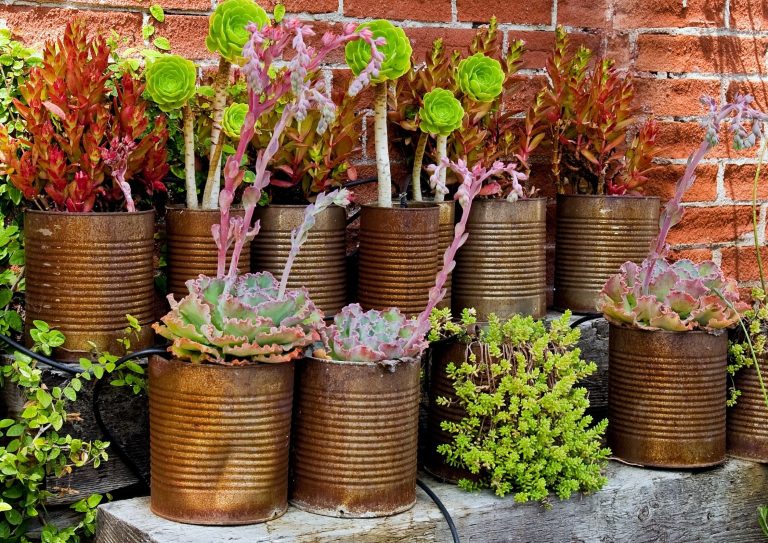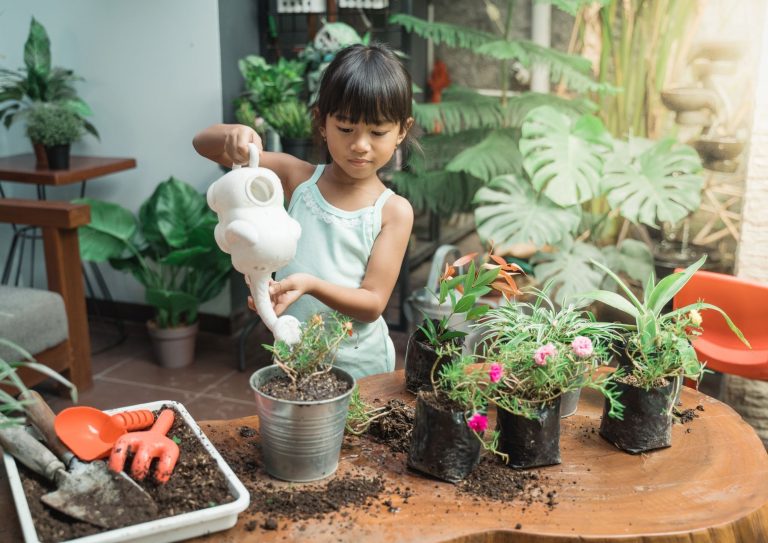Container gardening for kids is one of the ideal outdoor activities that should be tried. There are numerous benefits to teaching children to garden, ranging from educational to physical. One of the best aspects is that your children will enjoy it!
Kids are easily persuaded to dig in the dirt and get dirty. Due to a lack of resources or restrictions imposed by their neighborhood, many families are unable to grow a traditional garden. Container gardens are an excellent alternative and simple to set up, maintain, and produce a lot of produce.
Container gardening for children is a simple project that can be completed in an afternoon. It’s also an excellent way of introducing children of all ages to the joys of gardening
Following below are a few tips for getting started to set your container garden up for success!

How to Do Container Gardening for Kids
To start a garden in a container, you must fill the container with potting soil. These soil mixes are designed to keep a certain level of lightness so that plants can breathe, drain well, and retain some moisture.
Most plants require a little extra space to stretch their roots. Choose a pot that is slightly larger than the plant will need. Prevent root stomping by leaving some wiggle room. Allowing for some growth increases the chances of your plant reaching full maturity.
How to Choose Gardening Containers
Plastic pots are the most cost-effective container option. Despite being the least appealing option, they retain moisture longer than clay or ceramic pots and are lighter and easier to move around.
Kids can decorate their own containers and take ownership of the plant as it grows by painting artwork on them.
Next on the list of cheap things to buy are clay pots. They’re porous, so air can easily move through their walls. This is beneficial because it allows roots to breathe and keeps them out of direct water, but it is detrimental in that it causes the soil to dry out quickly.
There are a few factors to consider when selecting the best container for your plants: size, depth, and drainage. Your plant’s roots will need to grow in a container that is the proper depth, and drainage is critical to prevent water from pooling at the bottom of the container.
Container Placement
Most plants need six hours of sunlight per day. The same is true for salad greens and herbs. These sun-lovers will take all the sun they can get. If your garden lacks sun, consider adding caddies or casters. You can move these during the day or later in the season when the sun’s angle changes.
The wind is another factor. Your plants will thrive in a protected location away from the wind. Use a portable windbreak made of portable fencing or fabric.
Garden container ideas for kids
Tin cans are ideal for growing strawberries and are an excellent way to repurpose something that would otherwise be discarded. The cans should be larger. Make holes in the bottom for drainage and at the top for tying the string used to hang the cans. Allow your child to decorate the can to their heart’s content, and there you have it! The ideal strawberry-growing container.
Wooden container gardens need not be boring! Rustic large containers can be made from an old wagon or a whiskey barrel.
Old toys can be used as planting containers! You can pot succulents and herbs in truck beds, even doll heads.
Wouldn’t you agree that some of the ideas listed here are great gardening activities for children to participate in?
Celebrate April showers with rain boots as planters! You can decorate your fence with a row of brightly colored boots and then plant your favorite autumn flowers in them. The various sizes will add a nice decorative touch and get kids excited to see the progress of “their” flowers in their boots!


Choosing What to Grow in Container Gardens
It’s best to choose something that children can harvest on their own and enjoy eating.
There are a variety of vegetables and herbs that are ideal for container gardening for children:
- Snap peas and herbs. Both of which can be planted in the first few weeks of Spring are excellent choices. Herbs can completely transform the flavor of almost any recipe, and because most are of the cut-and-come-again variety, they can be used for long periods.
- Lettuces. These are also great to grow at home. They are small, germinate quickly, produce fresh greens for salads, and reproduce quickly. Young children will want to water and care for plants when they see greens growing from the soil. Beginning with soil preparation and garden bed assembly helps children connect with nutrients needed for plant growth and ownership of their garden.
- Tomatoes. Cherry tomatoes look fantastic, draped from hanging baskets.
- Potatoes. Once the growing season ends, your child gets to enjoy digging up handfuls of potatoes.
- Strawberries. Is there anything better than homegrown strawberries? It’s not uncommon to see people and their children walk out to a raised bed of strawberries during early Spring to early Summer first thing in the morning with a bowl in hand, dressed in their pajamas and rain boots, picking strawberries.
Why not grow your own delicious strawberries? This way, having fun with gardening can now be taken to a whole new level as you get your hands dirty with container gardening for kids.
Make it possible for your children to take responsibility for their containers and decide what to grow and where to grow it. They can grow their food in anything, whether it’s an old bread box or a birdbath!


Final Words
Experimenting with container gardening for children is an excellent way to get your kids interested in gardening by providing them with their own domain—without committing to a bit of land in your garden. Especially if you don’t have enough space or don’t have enough faith in your child’s budding green thumb to trust them with a patch of your garden.
Container gardens are a great alternative to traditional gardens, even more so when working with kids. Engaging in such activities will even allow your children to try their hand at creative container design.
Opting for container gardening for kids helps conserve space in your backyard, allows the kids to be resourceful, and teaches them the value of patience, which creates a win-win situation for all.
Related Posts
-
How to Create an Indoor Garden for Kids
Not all kids have access to gardens or even have a sunny balcony, so here…
-
Planting Activities for Kids
Growing Plants with Kids Can Be Fun! Are your kids spending more times on screens…
-
8 Best Kids Gardening Tools for your Little Gardener
In this article, we'll discuss the best kids gardening tools to help boost love for…




Pingback: 10 Benefits of Container Gardening for Kids | Fun Gardening for Kids